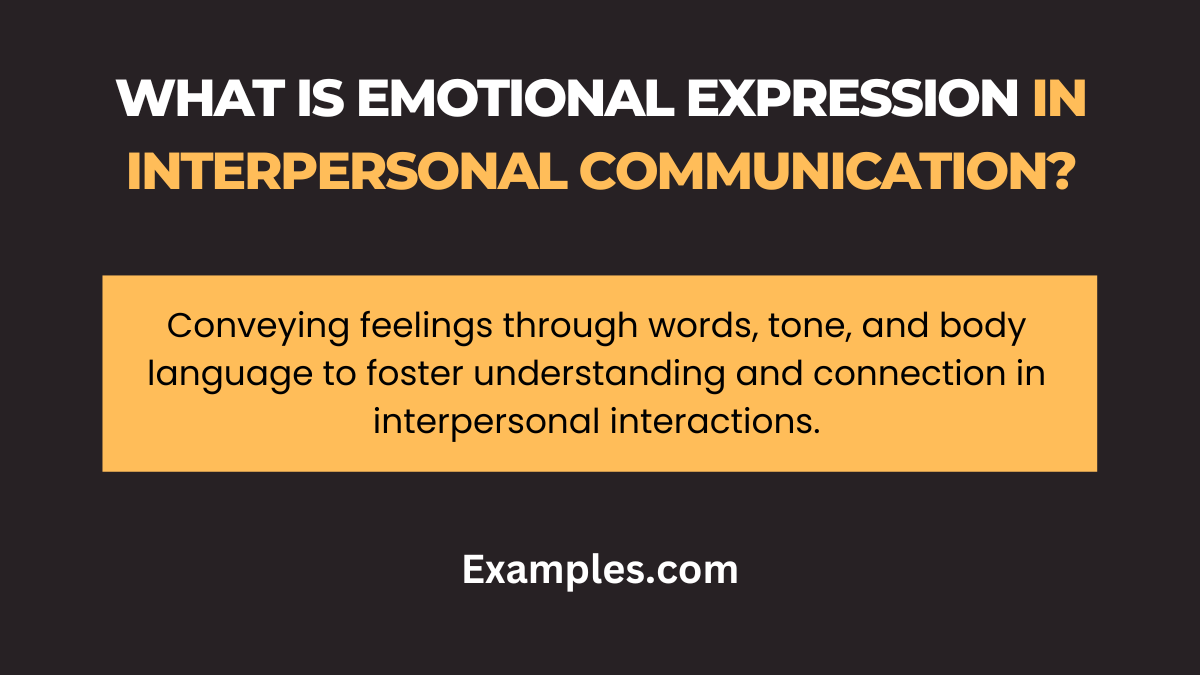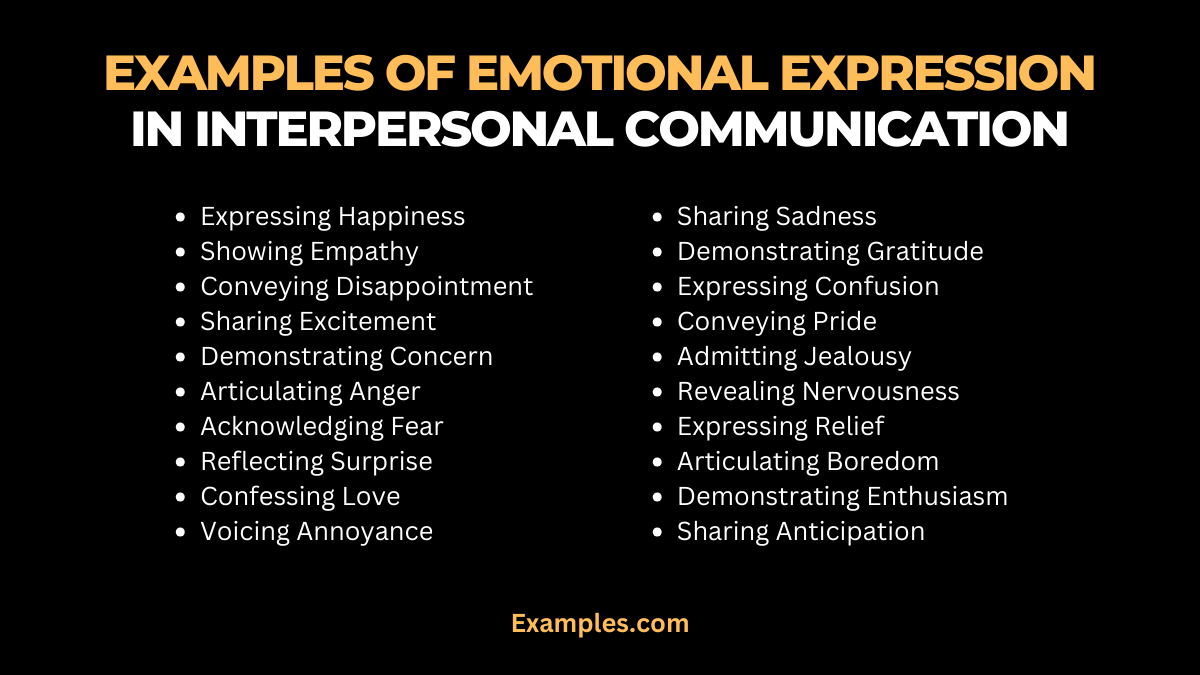19+ Emotional Expression in Interpersonal Communication Examples
In the realm of Interpersonal Communication, emotional expression plays a pivotal role in forging strong connections and enhancing understanding. This guide delves into the nuanced art of conveying emotions effectively, providing insightful examples and practical tips. Whether it’s in personal relationships, professional settings, or daily interactions, mastering the skill of emotional expression can significantly improve communication dynamics. We explore various aspects, from recognizing and understanding emotions to expressing them in a manner that is both authentic and considerate of others.
What is Emotional Expression in Interpersonal Communication?

Emotional expression is a fundamental aspect of Interpersonal Communication, involving the ability to convey feelings and emotions to others through various means. This expression can take multiple forms, including verbal cues, such as tone of voice and choice of words, and non-verbal cues, like facial expressions and body language. Effective emotional expression in interpersonal communication is not just about sharing one’s own feelings; it also encompasses the sensitivity and responsiveness to the emotions of others. It plays a crucial role in building rapport, empathy, and understanding in relationships. Learning to express emotions appropriately and interpret others’ emotional cues accurately is essential for healthy, meaningful, and successful interpersonal interactions.
20 Examples of Emotional Expression in Interpersonal Communication

Emotional expression is a vital component of interpersonal communication, playing a crucial role in conveying feelings and building relationships. Whether through verbal or non-verbal cues, emotional expression enhances understanding and empathy in interactions. Effective emotional communication involves being aware of one’s emotions and expressing them appropriately in various contexts. This skill is essential in all forms of interpersonal communication, from personal relationships to professional settings. Emotional intelligence, the capacity to be aware of, control, and express one’s emotions, and to handle interpersonal relationships judiciously and empathetically, is key in this process. Emphasizing emotional expression in interpersonal communication strengthens connections, fosters trust, and ensures that messages are conveyed with clarity and compassion.
- Expressing Happiness: “I’m really happy to hear that news! Your success brings me joy.”
Explanation: Sharing your happiness openly can positively influence the mood and encourage a deeper connection. - Showing Empathy: “I understand how challenging this must be for you. I’m here to support you.”
Explanation: Demonstrating empathy through words acknowledges and validates the other person’s feelings. - Conveying Disappointment: “I must admit, I’m quite disappointed we missed the deadline. Let’s work on not repeating this.”
Explanation: Expressing disappointment clearly and constructively addresses issues without assigning blame. - Sharing Excitement: “I’m thrilled about our upcoming trip! It’s going to be an amazing experience.”
Explanation: Communicating excitement not only shares your emotions but also invites others to share in your enthusiasm. - Demonstrating Concern: “I’ve noticed you’ve been quiet lately. Is everything okay?”
Explanation: Showing concern through attentive observation and gentle questioning can provide comfort and support. - Articulating Anger: “I’m feeling quite frustrated with how this was handled. Let’s discuss how to avoid this in the future.”
Explanation: Expressing anger in a controlled manner can lead to constructive dialogue and problem-solving. - Acknowledging Fear: “I’m a bit scared about making this decision. Can we talk it through?”
Explanation: Voicing fear invites understanding and support, and can lead to collaborative problem-solving. - Reflecting Surprise: “Wow, I didn’t see that coming! That’s quite a revelation.”
Explanation: Showing surprise can underscore the significance of the information shared and foster open communication. - Confessing Love: “I love how you always think of others. Your kindness is one of the things I love about you.”
Explanation: Expressing love and appreciation strengthens bonds and communicates deep affection. - Voicing Annoyance: “It bothers me when meetings start late. Can we aim for punctuality?”
Explanation: Conveying annoyance about a specific issue can lead to constructive changes in behavior. - Sharing Sadness: “I’m feeling pretty down today. I lost something important to me.”
Explanation: Sharing sadness can open up avenues for comfort and understanding from others. - Demonstrating Gratitude: “Thank you so much for your help. I really appreciate it.”
Explanation: Expressing gratitude acknowledges the efforts of others and strengthens relational bonds. - Expressing Confusion: “I’m a bit confused about the instructions. Can you clarify?”
Explanation: Voicing confusion seeks clarification and ensures accurate understanding of information. - Conveying Pride: “I’m so proud of the work we’ve accomplished together. We’ve really made progress.”
Explanation: Sharing feelings of pride can motivate and uplift the spirits of those involved. - Admitting Jealousy: “I felt a bit jealous when I saw your interaction. Let’s talk about it.”
Explanation: Addressing jealousy openly can lead to a discussion about underlying issues and strengthen trust. - Revealing Nervousness: “I’m quite nervous about this presentation. Any advice?”
Explanation: Sharing nervousness can elicit support and practical advice to ease anxiety. - Expressing Relief: “I’m relieved we resolved that issue. It was weighing on me.”
Explanation: Conveying relief after resolving a problem can provide closure and shared satisfaction. - Articulating Boredom: “I find these tasks monotonous. Can we explore more engaging projects?”
Explanation: Expressing boredom can lead to discussions about more motivating and stimulating work. - Demonstrating Enthusiasm: “I’m really enthusiastic about this new project. It aligns perfectly with my interests.”
Explanation: Communicating enthusiasm can be infectious and motivate others. - Sharing Anticipation: “I’m looking forward to our collaboration. I think we’ll do great things together.”
Explanation: Expressing anticipation sets a positive tone and fosters a forward-looking attitude.
Emotional Expression in Interpersonal Communication in the Workplace
- Acknowledging a Colleague’s Hard Work: “I really appreciate the effort you put into this project. Your dedication is inspiring.” This expression of gratitude and respect fosters a positive work environment.
- Expressing Concern for a Team Member’s Well-being: “I’ve noticed you’ve been under a lot of stress lately. Is there anything I can do to help?” Showing concern enhances team solidarity and care.
- Sharing Enthusiasm for a Project: “I am so excited about the new initiative we’re starting. It’s great to be working on this together!” Positively expressing enthusiasm can boost team morale and motivation.
- Voicing Frustration in a Constructive Way: “I’m feeling a bit frustrated with the delays in our timeline. Let’s discuss how we can address this together.” Constructively expressing frustration can lead to proactive problem-solving.
- Communicating Empathy During Difficult Times: “I understand that this has been a challenging phase for you. Please know that your contributions are valued.” Empathetic communication can provide comfort and support.
- Acknowledging Personal Milestones: “Congratulations on your work anniversary! Your growth here has been remarkable.” Celebrating personal milestones enhances a sense of belonging and appreciation.
- Expressing Disappointment Professionally: “I am disappointed we missed our target this quarter. Let’s work together to identify where we can improve.” Professionally expressing disappointment can motivate improvement.
- Sharing Job Satisfaction: “Working on this project has been very fulfilling for me. I’m grateful for this opportunity.” Sharing job satisfaction can reinforce a positive workplace culture.
- Addressing Interpersonal Conflicts Calmly: “I feel there’s been a misunderstanding between us. Can we talk about it openly?” Calmly addressing conflicts can lead to effective resolution and understanding.
- Offering Encouragement During Challenging Times: “I know this task is challenging, but I believe in your ability to handle it. You’ve got this.” Encouragement can boost confidence and resilience in the workplace.
Importance of Emotional Expression in Interpersonal Communication
- Enhances Understanding: Emotional expression in interpersonal communication plays a crucial role in conveying one’s true feelings and intentions, leading to a deeper understanding between individuals.
- Builds Trust and Rapport: Expressing emotions authentically helps in building trust and rapport, as it demonstrates honesty and vulnerability, which are key in forming strong, meaningful connections.
- Facilitates Conflict Resolution: In conflict situations, effectively communicating emotions can lead to quicker and more effective resolution, as it allows for the acknowledgment and addressing of underlying emotional issues.
- Improves Mental Health: Openly expressing emotions is therapeutic and beneficial for mental health, as it prevents the buildup of stress and negative feelings.
- Enhances Decision Making: Understanding and expressing emotions can contribute to better decision-making processes, as emotions are integral to evaluating situations and making choices.
- Promotes Empathy and Compassion: When individuals express their emotions, it fosters empathy and compassion in others, leading to stronger, more supportive relationships.
- Strengthens Team Dynamics: In a team or group setting, emotional expression can strengthen dynamics by creating an environment of openness and mutual support.
- Facilitates Personal Growth: Regularly expressing emotions contributes to personal growth and self-awareness, as it encourages individuals to understand and reflect on their emotional states.
Guidelines for Expressing Emotions in Interpersonal Communication
- Understand Your Emotions: Before expressing emotions, it’s essential to understand what you are feeling. Reflecting on your emotions helps in communicating them more clearly and effectively.
- Use ‘I’ Statements: Express emotions without placing blame by using ‘I’ statements. For example, say “I feel upset” instead of “You upset me.” This approach reduces defensiveness in others.
- Maintain Honesty: Be honest about your feelings. Authentic emotional expression builds trust and understanding in relationships.
- Control Intensity: While it’s important to be honest, regulating the intensity of emotional expression is crucial. Overly intense emotions can overwhelm others and hinder effective communication.
- Practice Active Listening: Active listening is an integral part of emotional expression in interpersonal communication. It involves paying attention, understanding, responding, and then remembering what the other person says.
- Non-Verbal Cues: Pay attention to non-verbal cues like facial expressions, gestures, and posture, as they can significantly impact the message you are conveying.
- Seek Clarity: If you’re unsure about the other person’s emotional state, ask clarifying questions. This helps in understanding their perspective and responding appropriately.
- Empathy: Show empathy by trying to understand and share the feelings of another person. Empathetic responses foster deeper emotional connections and more meaningful communication.
Effective Means of Emotional Expression in Interpersonal Communication
Verbal Expression
- Clearly Articulate Feelings: Use precise language to describe your emotions. Avoid vague terms and be specific about what you feel.
- Adjust Your Tone: Your tone should match the emotion you are expressing. A gentle tone conveys empathy, while a firm tone can express serious concerns.
Non-Verbal Expression
- Facial Expressions: Your face often reflects your emotions more accurately than words. Use facial expressions to complement your verbal messages.
- Body Language: Open and relaxed body language can convey positive emotions, while closed or tense body language might indicate negative feelings.
Written Expression
- Choose Words Carefully: In written communication, words are the primary way to express emotions. Choose words that accurately reflect your feelings.
- Use Emotive Language: Emotive language helps in expressing the intensity and depth of your feelings.
Digital Communication
- Emojis and Symbols: In digital communication, emojis and symbols can effectively convey emotions.
- Tone in Text: Be mindful of how your words might be interpreted. Without non-verbal cues, written words can sometimes be misinterpreted.
In conclusion, mastering emotional expression in interpersonal communication is vital for building stronger, more empathetic relationships in both personal and professional realms. Understanding and effectively conveying emotions not only enhances communication but also fosters deeper connections, trust, and understanding among individuals. For further insight into emotional intelligence and its impact on interpersonal relationships, the American Psychological Association provides valuable resources at apa.org. Additionally, the University of Minnesota offers an extensive guide on effective communication skills, which can be accessed at their website.
These resources offer a deeper exploration into the dynamics of emotional expression and provide strategies for improving communication skills in various interpersonal scenarios.



